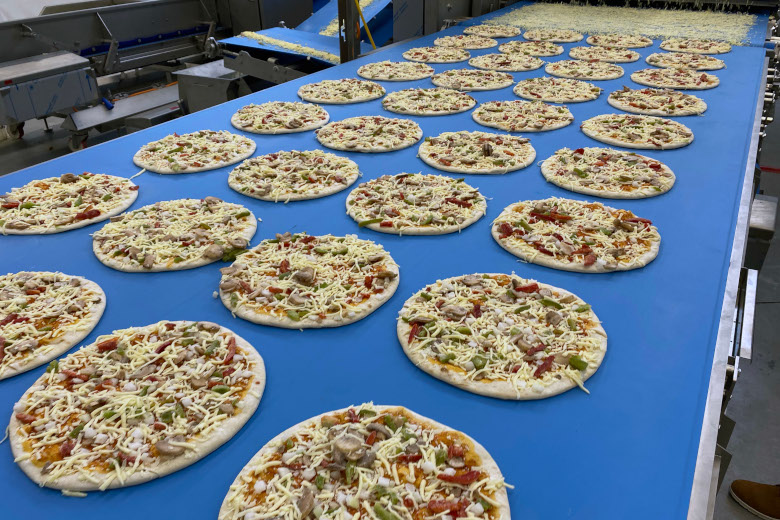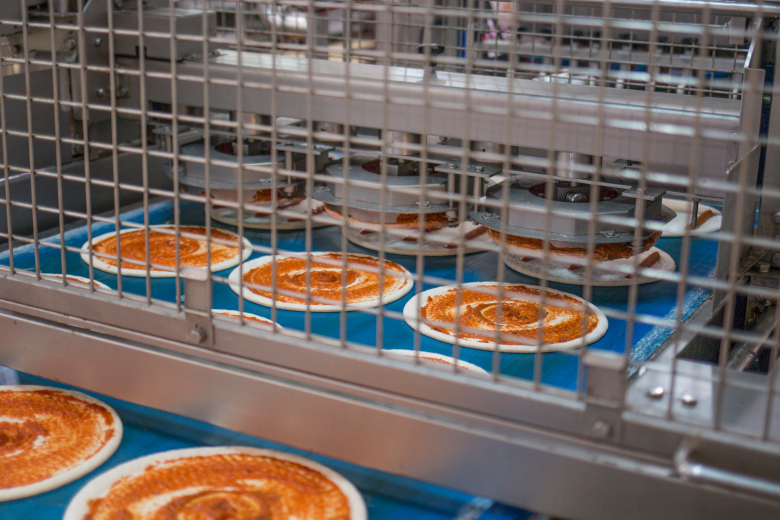
At home or at the restaurant, for lunch, office parties, or even for breakfast, ordered in person or online, the interest in pizza choices never fades. On the contrary, new, exciting taste offerings, product claims and ingredient combinations are welcomed opportunities to experiment.
The global pizza market size reached USD 141.1 billion in 2022 and Research And Markets expects it will reach USD 192.4 billion by 2028. Healthier product options such as vegan, low-calorie and gluten-free pizzas are drawing consumers in.
Rademaker pizza solutions
Pizza covers a very wide spectrum of process choices, especially for crust production. Are they produced on baking trays or not? At what stage in the process is fermentation/ proofing required (if at all)? All these aspects can impact the general design of a processing line. Rademaker determines these key decisions with the baker at the beginning of a project. “For example, crusts that must have a ‘fried’ bottom appearance are typically produced in baking trays,”Rademaker illustrates. This type of setup can start with mixing, then direct to sheeting and makeup, with products then transferred onto trays for proofing (step or spiral) and baking, then depanning, cooling, and so on.
On the other side of the spectrum are the more aerated products, with processes that are more similar to artisan bread lines. Here, mixing and pre-fermentation can require extended time intervals, with sheeting and forming optimized for higher hydration/fermented doughs. Continuous sheet proofing and sauce application can be incorporated in this case, prior to transferring the products to a higher temperature oven with a shorter bake time when compared to a tray process, Rademaker explains. Key considerations include the required production rate, which defines various widths and speeds.
New trends have also entered the market in recent years. “Just think of the shift from pizza to pinsa. Pinsa is a very airy and crispy ‘pizza’ type made of dough with a very high water percentage (>80%), a Biga or Sourdough with a very long proofing process,” Rademaker points out. All these different types of pizza require a specific sheeting process with a specific pre-sheeter for each group of doughs. A very soft, airy and strongly pre-fermented dough cannot be rolled out with an overly aggressive dough sheeter, as it would remove all the air from within the dough, for example.
Alternatively, thin and crispy pizzas are made with very low-hydration, stiff doughs – these require a ‘heavy-duty’ extruder.
Rademaker lines are designed for the specific type of dough for which it is needed. Rademaker has extensive experience in sheeting anything from “Very low hydration doughs, for more cracker types of crusts, to highly hydrated pre-fermented doughs, thick or thin bottom, soft and hard crumb structure, crispy or just soft, with and without pressed edges and pizza with a cheese filling in the edge,” the specialist lists. Even more niche applications can be supported, including incorporating ingredients such as corn meal, bread crumb to the bottom of the product, herbs/spices to the top, or oil application before baking. As for toppings, the most common configuration designed by Rademaker starts with target sauce application, followed by waterfall cheese, meat, or vegetable application, with target slicing in the middle for pepperoni/sausage. “The sequence depends on the product; cheese is delivered on demand from a shredding system. Other ingredients (meats and vegetables) are usually IQF in larger totes,” the specialist details. At the discharge of the topping line, depending on the market and materials, the pizzas will either be lightly sprayed with water or pass through a high temperature/short dwell cheese melter to ensure all the valuable toppings stay on the pizza through freezing.
Changeovers on a crust line can be as simple as changing a cutter for a different size/shape, which on a sheeting system can be done in a matter of seconds with a carousel. “For products on trays, these may need to be exchanged as well if there is a cavity involved,” Rademaker points out. As for topping, sauce and slicing heads will have to be changed for a new size/shape. “If different raw materials are introduced, these need to be emptied and started again, although larger producers will do this kind of changeover at a sanitation cycle, or switch to a redundant applicator for fast changeovers. Recipe control and management are standard to minimize the operator’s efforts to the physical changes needed,” Rademaker observes.
Accuracy is profitable
In recent years, Rademaker has been focusing its R&D on the development of in-line weighing systems of a continuous dough sheet. “This hybrid weighing system weighs the sheet continuously during the sheeting process and adjusts it into an exact volume; only then, it is formed into the desired pizza shape,” Rademaker explains. Improved weighing accuracy saves dough giveaways and spells big annual savings, especially for large-volume operations.
New systems have also been developed for Rademaker’s topping lines, with improved accuracy when spreading one of the most expensive products of a pizza – cheese. With algorithms monitoring ingredient recirculation to optimize feeding the applicator, topping accuracy brings significant savings. “By refeeding what is consumed and controlling what is on the line, material is added via a buffer system. A constant flow of material is thereby created so that the applicator is never overfed. In this way, a minimum amount of strewing material in the recirculation system is ensured. The algorithm further follows the ingredient flow through the system and adjusts the amounts that are re-introduced to the applicator,” Rademaker explains.
Compared to traditional pizza production from dough balls, sheeting technology allows long pre-fermenting processes to be done before the dough is sheeted, which significantly reduces processing time on the line and improves equipment output. Rademaker can easily scale up the capacity of its sheeting line, if needed, by increasing its line width to 1,600 mm wide. By using rotating guillotine blades that cut the desired shapes in the continuous dough sheet, high processing speeds are ensured. Moreover, “The large in-line belt proofer behind the sheeting line allows the continuous dough sheet to proof before cutting, which helps minimize production costs per item,” Rademaker observes. Pre-fermenting can also be done in bulk, before the dough enters the line, making variations possible in terms of flavor, crumb structure and crust properties.
With its newest developments for pizza production, Rademaker has been focusing on improving the reliability and accuracy of its sauce dosing systems and material flow stability on the topping applicators.
This article is part of an extended feature published in Baking+Biscuit International, issue 5 – 2023.
Photos: Rademaker



